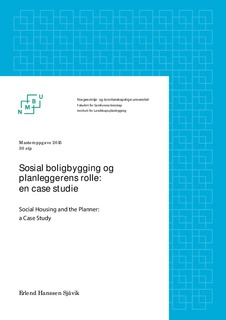| dc.description.abstract | Oppgaven tar for seg hvordan seks kommuner forstår sitt boligsosiale handlingsrom og hvordan planleggeren er knyttet til det boligsosiale arbeidet i nybyggingen. Teorien omhandler planleggerens rolle gjennom historien, idealer om hva planlegging skal være, og den kommunale planleggerrollen. Dette kobles til viktige boligpolitiske veivalg, som sammen med en gjennomgang av kommunens institusjonelle rammer er med på å forklare kommunens og planleggerens handlingsrom og hvilke virkemidler som fins i planloven som omfatter de boligsosiale arbeidet.
Gjennom å studere casekommunenes samfunnsdeler, boligsosiale handlingsplaner og andre relevante dokument, ble kommunenes utfordringer, boligstrategier og innsatsområder identifisert satt sammen med hvordan det boligsosiale arbeidet ble organisert i kommunene. Sammen med dybdeintervju av planleggere og fagpersoner innen sosialtjenesten danner det grunnlaget for empirien.
Funnene viser at noen kommuner forstå det boligsosiale handlingsrom å omfatte de mest vanskeligstilte på boligmarkedet, mens andre har en tilnærming som også ønsker å tilrettelegge for rimelige boliger i markedet. De fleste kommunene bygger boliger for det vanskeligstilte segmentet selv, men i to av casekommunene er det etablert gjennomføringsmodeller hvor man i samarbeid med private utbyggere eller boligbyggerlag får tildelingsrett i nye boligprosjekt. Slik lovgivingen er utformet, kreves det en merinsats av kommuner som ønsker å imøtekomme boligsosiale målsetninger utover det vanskeligstilte segmentet. En kommune har imidlertid etablert en gjennomføringsmodell for rimelige boliger i markedet, hvor kommunens tomteselskap tilrettelegge for byggeklare tomter og arrangerer prosjektkonkurranser. Dette kan sees som en respons til den markedsdrevne utviklingens negative eksternalitetene, og stiller spørsmålstegn til om virkemidlene i planverktøyet er tilstrekkelig for å håndtere de utfordringene en har.
Planleggeren involveres i varierende grad i kommunenes boligsosiale arbeid i nybyggingen. Det er kartlagt tre nivåer for deltagelse hvor arealplanleggeren er den vanligste planleggerrollen og er i liten grad knyttet til det boligsosiale arbeidet. Samfunnsplanleggeren tar del i kommunenes strategiske planlegging og utvikling av handlingsprogrammer, mens den koordinerende planleggeren jobber med å koordinere kommunens strategier og informasjon mellom etater og binde virkemiddel og tiltak sammen. At planleggeren ikke involveres mer må sees i lys av hvordan de institusjonelle rammene setter begrensninger for hva arealplanleggeren skal holde på med, men er også et utrykk for at planlegging er rettet mot en kommunes generelle utvikling og det ordinære boligmarkedet, mens de boligsosiale tiltakene og de vanskeligstilte skal håndteres av sosialtjenesten og andre tjenestefagfelt.
Abstract
The thesis examines how six municipalities understands their opportunity space concerning social housing, and how the planner relates to the processes of implementing social housing. With a historical take, I go through aspects that has had an impact on both planning theory and how Norwegian housing policy has changed after the Second World War. Followed by theory of municipal planning and institutional framework, I set the background for understanding the instruments that are available for the municipalities and the planner to deal with their social housing obligations.
The basis of the empirical data was interviews with planners and by gathering information from official municipal documents and housing strategies. This was done to uncover how the municipality was organized and how the planners understood their role and position.
The findings show that some municipalities understand their opportunity space concerning social housing to consist of the most disadvantaged in the housing market, while other municipalities have an approach that also wants to facilitate affordable housing. Most municipalities are building housing for the disadvantaged segment itself, but in two of the municipalities, it is established execution models where they collaborate with private developers, getting allotment rights in new housing projects. Because the planning legislation does not include paragraphs that allows the municipalities to request affordable housing within the planning institute, municipalities have to use their ownership in land to fulfil their goals of affordable housing. One municipality has therefore established an implementation model for affordable housing, where the municipal facilitate property for housing and hosts project competitions. This can be seen as a response to the negative externalities by a market-driven housing marked, and question whether the planning tools are adequate to deal with the challenges municipals face today.
The finding states that planner is not always involved in social housing schemes. The most common urban planners (arealplanlegger) are only marginally linked to the municipals social housing projects. On the other side, both the strategic/social planners (samfunnsplanlegger), which takes part in the developing of strategic plans and development programs, and the coordinating planners, witch work to coordinate municipal strategies and distribute information among municipal agencies, are working with social housing topics. The institutional framework set limits for whether or not the planner is involved with social housing topics. | nb_NO |

